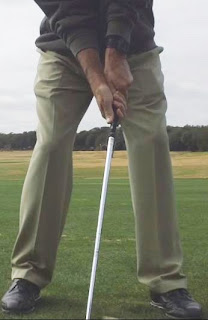 |
| BANG!...This back swing is too horizontal causing the club to strike the glass! |
The proper golf swing should be a blend of horizontal (body rotation) and vertical (wrist hinge). In the swing above, the club has way too much horizontal on the backswing and slammed into the glass. In other words the backswing was too shallow without enough vertical. In the take away, the club moved too much to the inside of the target line because I added a wrist roll instead of a wrist hinge. At this point in the back swing, the club should be working more vertical or "up" the glass as opposed to "into" the glass. This faulty backswing can cause a multitude of issues. If no manipulations are made to correct the mistake, the ball will usually go to the right (with a possible shank) and it would be hit very thin (no divot).
Now, if the club is swung too upright like a Ferris wheel, this would be considered too vertical. In this swing, there is definitely quite a bit of lifting of the arms going on. This backswing is way too vertical with little or no body rotation. Your divots are going to be very deep with this backswing and you would typically pull the ball to left field.
 | |||||
| This back swing is too vertical...note how high the right elbow is. |
We are looking for a backswing somewhere in the middle of these two as pictured below.
 |
| The perfect blend puts you in a powerful position at the top! |
I use three really good drills (use a short iron for these drills) to help position the backswing on the correct plane. In the first drill, I place a 3 foot long 2x4 about 3 inches inside the target line as a guide. If the board scares you, then use an alignment rod or rolled up towel instead. The ball is placed toward the front of the board so you won't strike the back of the board or the front of the board on the downswing through impact. The goal is to swing the club back along the board without the club coming across the board too early.
My club is more vertical in this picture compared to the picture at the top of the page. I will hit several shots making small swings so I can avoid the board on the back swing and forward swing. Tee the ball up so you can stay in the same spot without moving the board each time.
The second drill I use is place a foam noodle (over a shaft) in the ground as pictured below. The angle of the noodle is set the same as the angle of my shaft at address. If I take the club too far to the inside on the backswing I will hit the noodle.
My goal is to make
the angle of my club the same as that of the noodle when I am at the
halfway point in the backswing. This will happen is I get the correct blend of body rotation and wrist hinge. I recommend hitting quite a few shots
using small swings so you will not hit the noodle either on the backswing or the forward swing.
Performing any or a combination of these drills will help you get the feel of a great backswing. You will know when you are doing it correctly because your ball striking and direction control will improve immensely. We want to eliminate compensations in the golf swing and a great backswing accomplishes this!



















